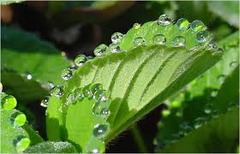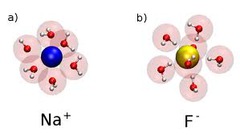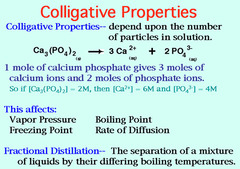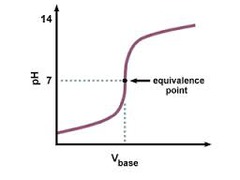Principles of Biochemistry Chapter 2 Water – Flashcards
Unlock all answers in this set
Unlock answersquestion
water is a ________ molecule
answer
polar; contains a positive and negative end
question
in water, oxygen has a slightly ________ charge
answer
negative
question
in water, hydrogen has a slightly ________ charge
answer
positive
question
one water molecule can bind with ______ other water molecules at the same time
answer
4
question
cohesion
answer
Attraction between molecules of the same substance
question
cohesion is made possible due to
answer
hydrogen bonds
question
adhesion
answer
An attraction between molecules of different substances
question
adhesion is made possible due to
answer
hydrogen bonds that bind to electronegative Os
question
surface tension
answer
linking together of water molecules on the surface of a body of water
question
surface tension is made possible due to
answer
hydrogen bonds
question
heat
answer
total amount of kinetic energy
question
temperature
answer
intensity of all the heat in a substance as the molecules move
question
water's ability to regulate temperature is due to
answer
hydrogen bonds
question
evaporative cooling
answer
The property of a liquid whereby the surface becomes cooler during evaporation, owing to a loss of highly kinetic molecules to the gaseous state.
question
water __________ when it freezes
answer
expands
question
four properties of water
answer
1. cohesion/adhesion 2. evaporative cooling 3. temperature regulation 4. water expands when it freezes
question
solvent
answer
A liquid substance capable of dissolving other substances
question
universal solvent
answer
water
question
solute
answer
A substance that is dissolved in a solution.
question
solution
answer
A mixture in which one or more substances are evenly distributed in another substance
question
hydration shell
answer
The sphere of water molecules around each dissolved ion
question
water can not grab and dissolve ________ molecules
answer
non-polar (oils, grease, fats)
question
hydrophobic
answer
"water fearing"
question
hydrophilic
answer
"Water loving"
question
dissociation
answer
splitting of water into H+ (proton) and an OH- (hydroxide ion)
question
acid
answer
substance gives away H+
question
base
answer
substance gives away OH-
question
pH scale
answer
measurement system used to indicate the concentration of hydrogen ions (H+) in solution; ranges from 0 to 14 pH =(-)logH+. A log scale.
question
buffer
answer
A solution that resists changes in pH when limited amounts of acid or base are added.
question
biocarbonate
answer
buffer found in human blood; keeps blood at a pH of 7.4
question
acid precipitation
answer
Rain, snow, or fog that is more acidic than pH 5.6.
question
causes of acid precipitation
answer
burning of fossil fuels; sulfur oxide and nitrous oxide combine with water
question
what bond makes water possible
answer
polar covalent
question
what bond provides the properties of water
answer
hydrogen
question
adhesion of water
answer
the water is attracted to the glass
question
cohesion of water

answer
water molecules are attracted to each other and form droplets
question
example of hydration shell

answer
the water molecules surround the molecules
question
surface tension of water
answer
Water molecules want to cling to each other. At the surface, however, there are fewer water molecules to cling to since there is air above (thus, no water molecules). This results in a stronger bond between those molecules that actually do come in contact with one another, and a layer of strongly bonded water. This surface layer creates a considerable barrier between the atmosphere and the water.
question
hydrogen acceptor
answer
atom, ion, or molecule component of a hydrogen bond which does not supply the bridging (shared) hydrogen atom Ie O or N
question
hydrogen donor
answer
the Hydrogen atoms that are ATTACHED to the electronegative atom (O N or F)
question
Hydrogen bonds
answer
The two strands of a DNA double helix are held together by _____ that form between pairs of nitrogenous bases.
question
dielectric constant
answer
Solvent polarity is a measure of solvent ability to separate opposite charges, which is expressed as _________. (E)
question
cathrate
answer
shell created around nonpolar substance by polar substances, decreases entropy
question
ampipathic
answer
Both hydrophobic and hydrophilic
question
micelles
answer
-consist of bile salts, fatty acids, monoglycerides and phospholipids all clustered together with the polar ends of each molecule oriented towards the micelle's surface and the nonpolar portions forming the core.
question
van der waals interactions
answer
weak attractions between molecules or parts of molecules that result from transient local partial charges
question
proton hopping
answer
Hydrogen bonded networks form natural chains for rapid proton transfer. Covalent and hydrogen bonds are interchangeable. Much faster than true diffusion, and results in extremely fast acid-base rxns.
question
colligative

answer
a property that is determined by the number of particles present in a system but that is independent of the properties of the particles themselves
question
osmotic pressure
answer
pressure that must be applied to prevent osmotic movement across a selectively permeable membrane when solutes are in water solution.
question
equilibrium constant

answer
a ratio of products formed at equilibrium to reactants formed at equilibrium. Products/Reactants
question
titration curve

answer
a graph of pH of a solution as titrant is added, expressed by a weak acid proton donor dissociates to become its conjugate base a proton acceptor. CH3COOH --> CH3COO- + H+. At equilibrium pKa = pH because changes in H+ concentration are buffered and line is stable.
question
Henderson Hasselbach
answer
pH= pKa + log (base(A-)/acid(HA))
question
condensation reaction
answer
A reaction in which two molecules become covalently bonded to each other through the loss of a small molecule, usually water; also called dehydration reaction.
question
Hydrolysis reaction
answer
this is when water (H2O) is added to a substance in order to break it up into smaller molecules. You can identify this as having a H2O reactant.
question
specific heat of water
answer
High compared to other substances. Allows Earth's large bodies of water to store heat and not be changed by small temp increases. Acts as a buffer. 1 Joule(Calorie) of heat energy needed to raise 1 Gram, 1 Degree higher.
question
Kw = [H+][OH-] = 1x10^-14
answer
Ion product of H2O
question
pH of a solution
answer
pH = -log_10[H+]
question
Logarithmic functions are closely related to exponential equations
answer
log_b (x) = y says the same thing as b^y = x.



